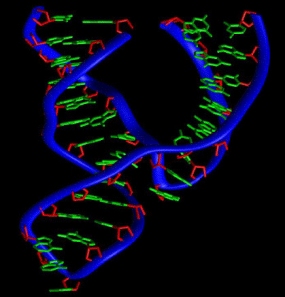Viruses with integrated gene switch
Scientists of the German Cancer Research Center (DKFZ) have developed “RNA switches” which allow them to specifically turn on and off genes in viruses. This will help to enhance regulation of gene therapy and viral therapy of cancer.
Numerous viruses are used in the service of science today. They serve as gene taxis to transfer therapeutic genes into body cells or as therapeutic viruses targeted to infect and destroy cancer cells. For such applications, the viruses are often equipped with additional genes, such as for immune mediators or for proteins inducing programmed cell death. However, these gene products can harm the body if they are released at the wrong moment or at excessive levels. “Ideally, we want to be able to turn on and off the transferred genes at a specific time,” says Dr. Dirk Nettelbeck, a virologist from DKFZ.
To this end, Patrick Ketzer of Nettelbeck’s group experimented, jointly with colleagues from Konstanz University, with what are called RNA switches. In order to construct such a switch, the researchers inserted synthetic segments of DNA into the viral genetic material in the direct vicinity of the transferred gene. In the infected cell, this construct is transcribed together with the transferred gene into a single messenger RNA (mRNA) molecule. The switch is operated using an agent which is added to cells infected with the virus. The substance is precisely fitted to bind to the RNA molecule and induces it to cut itself up. Thus, the potentially dangerous protein cannot be produced. The researchers copied this regulation mechanism from bacteria which use RNA switches to regulate production of numerous proteins.
The DKFZ virologists first constructed an RNA switch that is kept in permanent “off” position by the substance. The production of the foreign protein does not start as long as substance is added. “This was a first proof that RNA switches work in viruses at all. But it is just as well possible to construct switches that do not allow production of the protein until the substance is added,” Dirk Nettelbeck explains.
In cells, it has been possible for many years now to specifically turn on and off genes. To do so, scientists modified specific natural regulatory regions called promoters in the cellular genetic material. As a result, addition of the antibiotic tetracycline causes mRNA production to be turned on or off.
“However, this type of switch is too big and complex to be used in viruses or doesn’t work there,” says Dirk Nettelbeck. “The RNA switches, in contrast, are only 100 base pairs long.” Using the RNA switches, the researchers managed to increase the production of the therapeutic gene by ten times. “But there is still room for a lot more,” Nettelbeck explains. “The construction of RNA switches is extremely variable. Once the technology is fully developed, we will be able to better equip and regulate viruses for many therapeutic applications.” Nettelbeck and his team are convinced that the useful RNA switches will become established for many other uses in research and medicine.
Patrick Ketzer, Simon F. Haas, Sarah Engelhardt, Jörg S. Hartig and Dirk M. Nettelbeck: Synthetic Riboswitches for External Regulation of Genes Transferred by Replication-Deficient and Oncolytic Adenoviruses. Nucleic Acids Research 2012; doi:10.1093/nar/gks734.
With more than 3,000 employees, the German Cancer Research Center (Deutsches Krebsforschungszentrum, DKFZ) is Germany’s largest biomedical research institute. DKFZ scientists identify cancer risk factors, investigate how cancer progresses and develop new cancer prevention strategies. They are also developing new methods to diagnose tumors more precisely and treat cancer patients more successfully. The DKFZ's Cancer Information Service (KID) provides patients, interested citizens and experts with individual answers to questions relating to cancer.
To transfer promising approaches from cancer research to the clinic and thus improve the prognosis of cancer patients, the DKFZ cooperates with excellent research institutions and university hospitals throughout Germany:
The DKFZ is 90 percent financed by the Federal Ministry of Education and Research and 10 percent by the state of Baden-Württemberg. The DKFZ is a member of the Helmholtz Association of German Research Centers.


